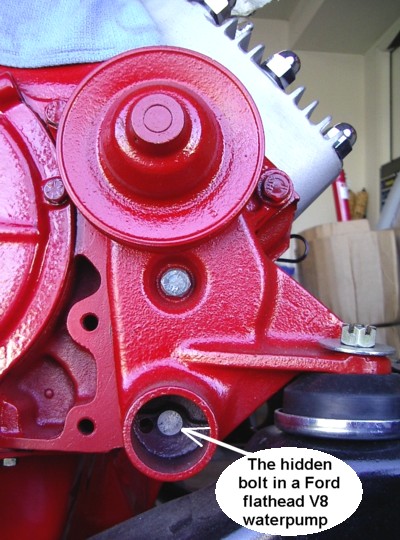|
Flathead Ford Water
Pumps |
||||
|
|
||||
|
Home Parts Drawings Web Links Tune-Up & Service Serial Numbers Engine ID Trans ID Model Identification Terms of Sale Contact Us Our Online Store Our Catalog |
The Trick to Removing Those Pump Bolts | |||
|
The Ford flathead V8 engines produced from 1932 to 1954 were designed with twin water pumps. From 1932 to early 1937 Ford's water pumps were mounted to the front of the cylinder heads (left and right). In 1937 Ford changed the design to create pumps that doubled as the front motor mounts. They bolt up to the lower front sides of the engine (left and right). There are several variations of this design, depending on the year vehicle and whether it was a truck or passenger car. Thus, the pumps could have the wide groove pulleys or the later narrow groove. Likewise, they could have a short snout or long snout. However, they still mount the same way. Often, when tearing down a flathead V8 engine, the novice is not aware of the "hidden" bolt of the four that hold each pump to the engine. You can easily see the hex heads of the three other bolts, but the 4th bolt is actually located inside the pump's hose fitting. In order to see this bolt, one must remove the lower radiator hose from the pump, and look inside the casting. It is a 9/16" hex head bolt just like the other three. An important suggestion....use a six sided socket on this bolt! Ford used regular steel bolts on the pumps. The one inside the hose fitting can possibly be corroded badly and slip in the socket wrench as you try to turn it. Don't use a 12 point socket as you will likely round off the corners of the bolt before it loosens. Should the bolt head be so badly corroded that a wrench won't turn it at all, you will have to resort to more aggressive means to remove it. First, try using one of those bolt remover sockets. They have a hardened spiral inside that grips what is left of the bolt head to help turn it out (available from Sears and other automotive tool suppliers). Should that fail to grab and remove the bolt, it may mean a cutting torch, reaching inside the pump to melt away the head of the bolt. Another final way is to destroy the pump's lower casting (either by cutting torch or by cold chisel and hammer) to expose the bolt to whatever means you have to cut it off. This will ruin the pump and destroy its value for rebuilding or using as a core exchange for a rebuilt pump. However, if it's the only way to get the pump off, so be it. Finally, when it comes time to rebuild the engine, and you are mounting your new or rebuilt pumps, take this precaution. First, use a stainless steel bolt in place of the regular steel bolt. Second, put a bit of thread sealer on the new bolt. You may not ever have to remove it, but someone, someday may need to, and you can help the process become easier by taking this step now. |
||||
|
|
||||
|
The pump shown on the left is from a 1949-52 late style 8RT truck engine. The pump on the right is from a 1946-48 "59" series passenger car engine. The late style pump has a narrow pulley and a longer snout, spacing the pulley out further from the engine. The 59A series pump shown has the wide groove pulley and the short snout, keeping the pulley close to the pump body. |
||||


